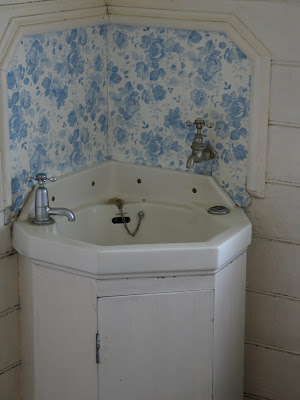
The bodice, is made from white cotton lawn, embroidered with white cotton thread.
This photo shows where the once long skirt was cut off, by someone who understood what a treasure it was, and the days and days of work, that would have gone into making it.

The bodice has been repaired many times, here under the arm you can see where it has been darned, to hold the worn fabric, and strengthen it, so that it could be worn by one more descendant of the family, to one more Christening.

There is a repair under the other arm too.

Look at those divine little sleeves, with their delicate hand embroidered frills of cotton lawn. All the embroidery on this bodice was done by hand, the frills are made of strips of the cotton lawn, the holes formed with a stiletto, and then sewn around with buttonhole stitch, the scalloped edges embroidered with the scalloped pattern, and then cut to the scalloped shape. I would love to iron this garment and then photograph it again, as it would look so much better if it had been ironed. However for something this old, I would advise talking to a textile conservator before putting an iron anywhere near it, as it is approximately 150 years old.
Look at that detail. The front of the bodice is worked with rows of piping cord sewn into folds of fabric, and rows of embroidery running down the front panel.

I think the embroidery is Mountmellick work, popular from the 1850's through to the 1880's. The style was started in surprise, surprise, my cherished darlings, Mountmellick, a small town in Ireland. In the 18th century it was a thriving industrial town, with cotton thread and fabric manufacturers. The cotton industry was huge in Britain at this time, and used imported cotton to weave fabric and make thread.
The style of Mountmellick embroidery was started in the 1820's by Mrs. Johanna Carter, a member of the Quaker movement, who decided to help local people through their difficult times by providing work for local distressed gentlewomen. It became a cottage industry, as the stitches were easy to learn, and the textile working tools needed, accessible to most women. Mountmellick work is always worked in white cotton thread on white cotton fabric, with large simple stitches, and is quick and easy to do. This is a wonderful example of it, and was worked by a skilled needlewoman.

The back of the bodice.

It closes simply at the back, with two tiny covered buttons, and two drawstring cords, one on the neck and one on the waist. The gown is completely hand stitched, and finely done.
Look how beautifully the ends of the drawstring housing are finished, with a delicate blanket stitch.

There is so much wonderful detail in this little remnant, even the drawstring cords were made by hand, especially for the gown. Aren't they wonderful?
 There are repairs on the back of the bodice, more areas of darning.
There are repairs on the back of the bodice, more areas of darning.The darning repairs are little works of art in their own right, really aren't they.

Just had to show another shot of the sleeves, this is from the back.

You can see how tiny these buttonholes are beside my fingertips, and the delicate little buttonhole stitches used to finish them.




















 So let me show you how the embroidery on the coat is going too. Remember the Best Way No. 16 coat that I have been working on.
So let me show you how the embroidery on the coat is going too. Remember the Best Way No. 16 coat that I have been working on.














 Paint finishes have been used in this room too, in this instance to imitate wood rather than marble, and to create the illusion of a wood considered more prestigious than the solid kauri they are made of, English oak.
Paint finishes have been used in this room too, in this instance to imitate wood rather than marble, and to create the illusion of a wood considered more prestigious than the solid kauri they are made of, English oak.





